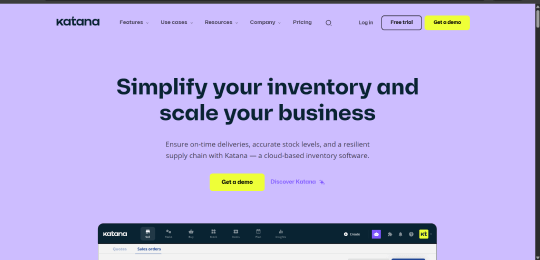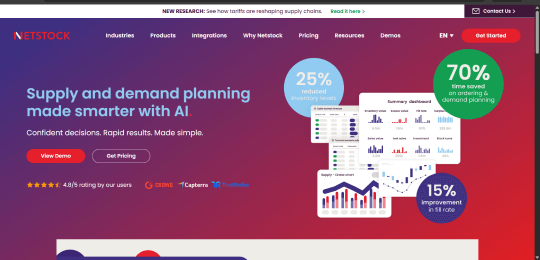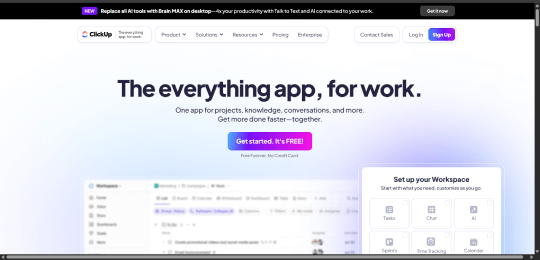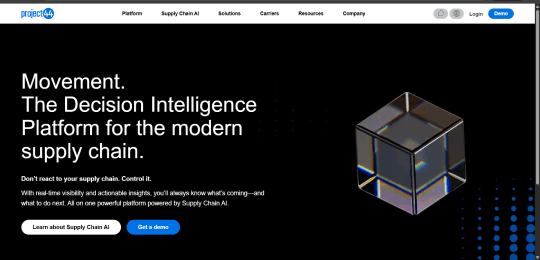Written by Marijn Overvest | Reviewed by Sjoerd Goedhart | Fact Checked by Ruud Emonds | Our editorial policy
What is AI in Inventory Management? Definition + 10 Best Tools
Table of contents
- What is AI Inventory Management?
- The 10 Best AI Tools for Inventory Management
- How AI Can Improve Inventory Management
- What are the Benefits of AI in Inventory Management?
- What are the Challenges Associated With AI Inventory Management?
- New Trends in AI for Inventory Management (2025)
- Conclusion
- Frequently asked questions
What is AI inventory management?
- AI inventory management uses artificial intelligence to automate stock control and optimize inventory levels in real-time.
- AI inventory management leverages machine learning algorithms to forecast demand and trigger timely replenishment.
- AI inventory management integrates predictive analytics with ERP systems to ensure efficient inventory planning and reduced human error.
What is AI Inventory Management?
AI inventory management includes the use of modern technologies such as machine learning, predictive analytics, computer vision, and robotics with the aim of controlling the stock level, forecasting, and automatically supplement processes without manual entry. Continuously analyzing historical data on selling and real-time suppliers from ERP or IoT systems, these solutions identify forms, predict future requirements, and ensure that products are available at the right time, significantly reducing human errors.
Unlike traditional static methods, AI platforms integrate live data from all sales channels and autonomously generate recommendations for purchase, detection of anomalies, and rebalancing inventories. This approach helps reduce carrying costs while avoiding inventories. Organizations ranging from e-commerce to large manufacturers benefit from improved precast of predictions, reduced levels of security, and scalable solutions that enable staff to focus on strategic activities, showing that AI brings tangible value.
The 10 Best AI Tools for Inventory Management


1. Katana Cloud Inventory
Built for manufacturing-focused SMEs, Katana fuses real-time inventory tracking, production scheduling, and sales-order management in one cloud dashboard.
Its AI layer reads sales trends and live shop-floor data to suggest reorder quantities, rebalance materials across work centers, and flag batch issues the moment they arise.
Barcode scanning and serial-number traceability make recalls painless, while visual drag-and-drop planning lets planners see capacity clashes before they hit.
Because the platform connects to Shopify, Amazon, QuickBooks, and leading ERPs, updates flow automatically across every channel. Users report higher OTIF rates and slimmer safety stock after switching from spreadsheets.
Price
Pricing varies by plan: $179–$399+ (Starter $179, Standard $359, Professional $799, Pro Plus $1,799)

2. IBM Supply Chain Intelligence Suite
IBM combines Watson AI with the Sterling control-tower backbone to ingest EDI feeds, IoT sensor data, and external risk signals.
Machine-learning models predict demand swings, recalculate safety-stock buffers, and surface plain-language “next-best actions” so planners trust the math.
Multi-tier visibility links suppliers, carriers, and DCs, letting teams reallocate constrained parts to high-margin orders in seconds. Integrated CO₂ dashboards weigh carbon against cost when recommending replenishment moves.
Large enterprises credit the suite with double-digit inventory reductions and sharper service-level compliance.
Price
Contact sales. Quote required (no public pricing).

3. Linnworks
A favorite of multichannel retailers, Linnworks applies AI to forecast SKU-level demand, trigger automated reorders, and keep stock synchronized across marketplaces, webshops, and brick-and-mortar locations.
Real-time dashboards show current levels, committed orders, and inbound POs side by side, eliminating blind spots. Rule-based automations handle kit assembly, back-order allocation, and courier selection without human clicks.
Because the engine learns from every sale, forecast accuracy improves continuously, freeing cash from overstocked SKUs. Native integrations with Amazon, eBay, Walmart, and Shopify make scaling effortless.
Price
Free for basic features; Professional ~$200; Corporate ~$1,390+
Note: The price depends on the plan and options.

4. Netstock AI (Predictor)
Netstock slots on top of almost any ERP and brings an AI “inventory expert” that translates raw data into clear, actionable recommendations.
With one click, the Predictor engine spots excess, stock-outs, and potential demand spikes, then proposes reorder quantities ranked by financial impact. Scenario tools let planners test targets for working-capital, service-level, or margin goals before committing POs.
Drill-downs expose supplier reliability issues and ABC classifications, supporting smarter negotiations. SMBs praise the app for delivering enterprise-grade optimisation without the price tag.
Price
Contact Netstock. No public pricing. Quote required.

5. Shopify (Sidekick & Shopify Magic)
For merchants on Shopify, built-in AI “Sidekick” assistants analyze historical orders, site traffic, and seasonality to recommend optimal reorder points and highlight at-risk SKUs.
Automated purchase-order drafts appear inside the admin panel, while low-stock alerts push to mobile so owners can act on the go. The same AI rewrites product descriptions and predicts bundle opportunities, aligning content and stock decisions.
If you operate POS locations, inventory moves seamlessly between online and offline channels to prevent overselling. All logic runs natively in Shopify, meaning no extra integrations or data pipes.
Price
Included with Shopify plans. Free for all Shopify users.

6. ClickUp
Though best known as a work-management suite, ClickUp’s Inventory template and “Brain” AI turn task boards into live stock dashboards.
Teams attach SKU fields to tasks, and the AI watches due dates, status changes, and sales figures to flag looming shortages or recommend reorder tasks. Automations can create POs, assign warehouse picks, or send Slack alerts when thresholds hit, removing spreadsheet juggling.
Multiple views (Gantt, Kanban, Calendar) give each stakeholder the layout they prefer without duplicating data. Its generous free tier helps startups pilot AI inventory workflows before investing in heavier ERP modules.
Price
Pricing is per user: Unlimited $10 per user; Business $19 per user.

7. Zoho Inventory
Zoho wraps multi-warehouse tracking, barcode/RFID support, and order-to-cash workflows in an interface that SMEs can master in days. AI routines forecast seasonal demand, automate replenishment, and pick the cheapest shipping service on each order.
Advanced analytics add 100+ pre-built dashboards covering aging stock, warehouse efficiency, and profit by item, while workflow rules push low-stock alerts to email or mobile.
The system syncs with Zoho’s CRM, Books, and Commerce apps for end-to-end visibility. Flexible tiers, from a free starter plan to enterprise bundles, let companies grow without replatforming.
Price
Monthly payments are available: $29 Standard, $79 Professional, $129 Premium, $249 Enterprise (billed annually).

8. Project44 Movement
Movement is an AI-powered decision-intelligence platform that tracks every SKU in transit (truck, rail, ocean, or air) and predicts ETA disruptions before they bite. Real-time location pings merge with weather, port congestion, and customs data to update PO arrival times inside the ERP automatically.
When risk crosses a threshold, the system proposes diversions, expediting, or inventory transfers to protect service levels with the lowest cost. Dashboards summarise network health for executives while APIs stream shipment-level insights to WMS and TMS tools.
Users report freight savings and slimmer buffer stock once they trust inventory “in motion.”
Price
Enterprise-focused; quotes on request. Starts at $6,250+ per month.

9. FourKites Intelligent Control Tower™
FourKites goes beyond visibility by layering AI “digital workers” that autonomously reschedule docks, alert stores, and trigger inventory transfers when late trucks threaten stock-outs.
A real-time digital twin unites orders, shipments, inventory, and facilities, letting teams see ripple effects weeks ahead. Machine-learning models learn lane-specific lead times to refine OTIF predictions and cut premium freight.
Carbon-aware routing analytics help logistics teams balance cost, service, and sustainability in a single view. Brands processing millions of loads daily trust FourKites to prevent disruptions rather than explain them after the fact.
Price
Contact sales. No public pricing. Quote required.

10. Coupa Supply Chain Design & Planning (powered by LLamasoft)
Coupa’s Guru X engine builds a digital twin of your network, then runs thousands of “what-if” scenarios (plant shutdowns, tariff hikes, demand surges) to pinpoint the lowest-cost, highest-service inventory policy.
Optimization routines recommend SKU-level targets, transport modes, and facility footprints, all ranked by cost, carbon, and risk. Interactive analytics let users swap assumptions on the fly and instantly see margin impact, cutting decision cycles from weeks to hours.
Outputs can be exported straight into ERP master data or tactical S&OP decks. Enterprises report inventory savings and faster response to shocks like COVID-era port closures.
Price
Contact sales. No public pricing. Quote required.
How AI Can Improve Inventory Management
AI transforms inventory control from a reactive bookkeeping chore into a self-optimizing, data-driven engine that anticipates demand, automates routine moves, and keeps capital working harder. Concretely, it does this through several interlocking processes:
1. Predictive demand forecasting
Machine-learning models sift through years of transaction data, promotions, seasonality, and external signals such as weather or influencer buzz. They recognize non-obvious patterns humans miss and recalculate forecasts with every new data point. The result is SKU-level accuracy that slashes both stock-outs and dead stock.
2. Dynamic reorder points & automated purchasing
AI continuously recalculates min-max levels as demand forecasts, lead times, and service-level targets change. When inventory dips toward the new threshold, the system instantly drafts purchase orders or triggers inter-warehouse transfers. Planners are alerted only for exceptions, not routine replenishment.
3. Adaptive safety-stock optimization
Algorithms balance demand volatility, supplier reliability, and in-transit variability to set the leanest possible buffers. Safety-stocks shrink or expand automatically as conditions shift. This frees working capital while still hitting target fill rates.
4. Real-time visibility & anomaly detection
Dashboards stream barcode, RFID, IoT, and computer-vision data into a single view of stock health. AI flags irregular shrinkage, sudden demand spikes, or mis-picks the moment they occur. Teams can intervene before small discrepancies become costly write-offs.
5. Warehouse & picking optimization
AI analyzes product velocity, cube size, and travel paths to generate optimal slotting maps and pick sequences. It can dispatch autonomous mobile robots or reassign staff to high-priority lanes. Shorter travel distances translate into faster fulfilment and lower labor costs.
6. Inventory rebalancing across the network
Models weigh transport costs, demand hot spots, and promised service levels to suggest lateral transfers or forward-positioning stock. Recommendations arrive days before a regional spike hits. This cuts last-mile costs and preserves delivery speed.
7. Supplier performance analytics & risk sensing
Pattern-recognition tools grade vendors on lead-time drift, on-time-in-full rates, and defect incidents. AI highlights risk thresholds and suggests dual-sourcing when a supplier’s score falls. Data-driven insights replace gut feel in vendor negotiations.
8. Scenario simulation & what-if planning
Generative models let planners test shocks such as a ten-day supplier delay or a flash sale in two regions. Each simulation returns cost, service, and inventory impacts within seconds. Decision-makers can choose the best trade-off with hard numbers in hand.
9. Continuous learning loop
Every forecast vs. actual, pick-path vs. time, and promise vs. delivery gap feeds back into the model. Algorithms retrain automatically, so accuracy improves with each cycle. Human teams focus on strategy while the system keeps getting smarter.
What are the Benefits of AI in Inventory Management?
What are the Challenges Associated With AI Inventory Management?
New Trends in AI for Inventory Management (2025)
1. Digital Twins & Scenario Simulation
Digital twins create virtual replicas of warehouses, supply networks, or even entire value chains. AI uses these digital twins to run thousands of “what-if” scenarios, testing inventory strategies, layout changes, or disruption responses before implementation in the real world. Companies can simulate plant shutdowns, demand surges, or supplier delays to understand financial and service impacts instantly.
This trend drastically reduces planning risks and shortens decision-making cycles from weeks to hours. It empowers supply chain teams to prepare for disruptions rather than react to them proactively.
2. Enhanced Predictive Forecasting
AI models for demand forecasting are becoming more sophisticated, incorporating reinforcement learning and generative AI techniques. These models analyze large datasets, including historical sales, promotions, weather, and social media trends, to identify complex patterns.
As a result, they deliver higher forecast accuracy, especially for sparse or volatile demand items. Businesses using these enhanced forecasts experience fewer stock-outs and reduced excess inventory. Over time, these models continuously learn and improve, creating a self-optimizing forecasting system.
3. Integration of Blockchain for Traceability
Blockchain is increasingly integrated with AI in inventory management to enhance traceability and security. By recording every inventory transaction on a distributed ledger, companies gain transparent and tamper-proof stock records.
When combined with AI analytics, this ensures authentic, verifiable data for decision-making. It also helps track the origin and movement of products across complex supply chains, preventing counterfeits and ensuring compliance. This trend is crucial for industries with strict regulatory requirements, such as food and pharmaceuticals.
4. Sustainable & Carbon-Aware Decision-Making
AI systems are now programmed to factor in environmental and sustainability metrics when optimizing inventory decisions. For example, they consider transport emissions, packaging waste, and energy use when recommending stock moves or supplier selections.
This helps companies align inventory practices with corporate sustainability goals and regulatory standards. It also improves brand reputation among eco-conscious consumers. Ultimately, carbon-aware AI decision-making balances cost efficiency with environmental responsibility.
5. Warehouse Robotics & Smart Picking
AI-guided warehouse robotics, such as autonomous mobile robots and drones, is becoming mainstream. These systems analyze product velocity, size, and location to optimize pick routes and reduce travel time for workers. Smart shelf systems combined with computer vision keep a real-time track of stock, flagging discrepancies instantly.
As a result, order fulfilment becomes faster, more accurate, and less labor-intensive. Companies adopting these technologies report significant improvements in warehouse productivity and cost efficiency.
Conclusion
The application of AI in inventory management represents a significant step towards modernizing supply chains and optimizing business processes.
Instead of relying on traditional static reorder points and manual demand forecasts, AI enables companies to automate processes, improve forecasting accuracy, and minimize inventory handling errors.
This ensures optimal product availability while reducing storage costs and excess stock, directly impacting profitability and competitive advantage.
Although the benefits of AI solutions for inventory management are numerous, their successful implementation requires adequate infrastructure, high-quality data, and employee readiness to adopt new technologies.
Once these challenges are overcome, AI becomes a powerful tool that transforms inventory management from a reactive function into a proactive strategic process, empowering companies to respond more quickly to market changes and customer needs in today’s business environment.
Frequentlyasked questions
What is AI inventory management?
AI inventory management is the use of AI technologies, such as machine learning and predictive analytics, to automate stock control, demand forecasting, and replenishment, ensuring accurate inventory levels with minimal human intervention.
How does AI improve inventory management efficiency?
AI improves inventory management efficiency by analyzing historical sales data, real-time signals, and supplier lead times to generate precise demand forecasts and dynamic reorder points, reducing stock-outs and excess inventory.
What are the main challenges of AI inventory management?
The main challenges of AI inventory management include ensuring high-quality data, integrating AI systems with existing inventory software, and training staff to effectively use AI tools for accurate and automated inventory control.
About the author
My name is Marijn Overvest, I’m the founder of Procurement Tactics. I have a deep passion for procurement, and I’ve upskilled over 200 procurement teams from all over the world. When I’m not working, I love running and cycling.





